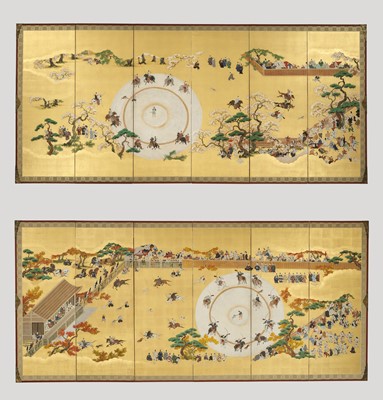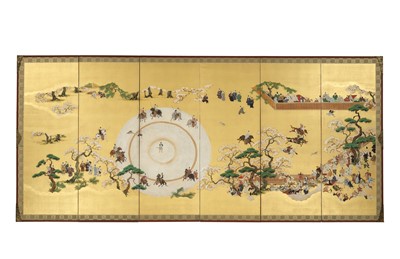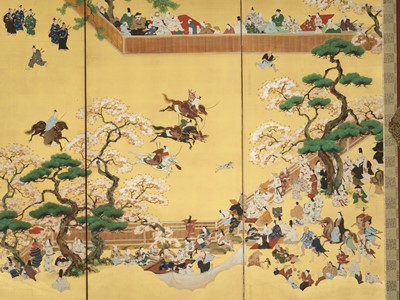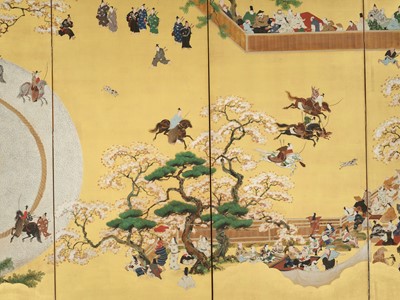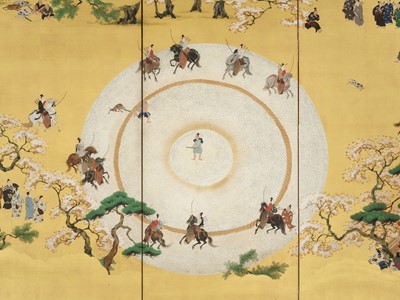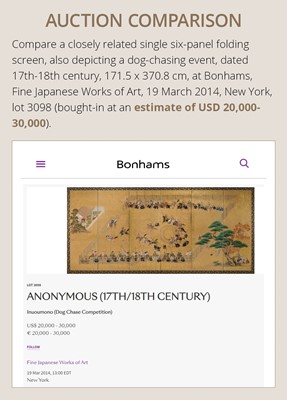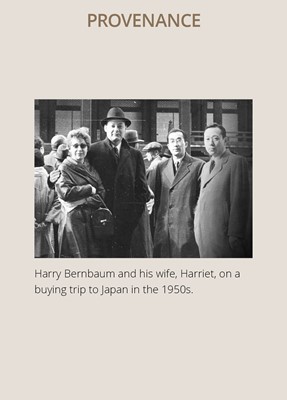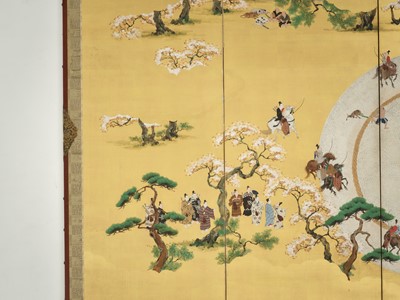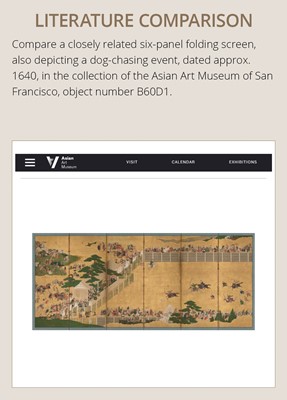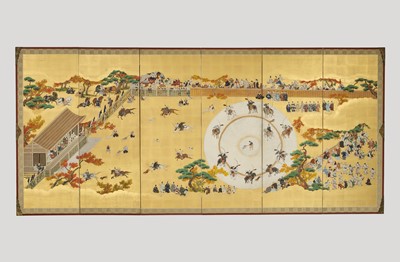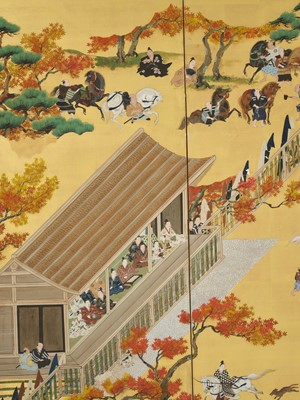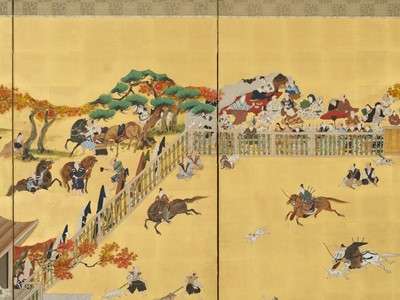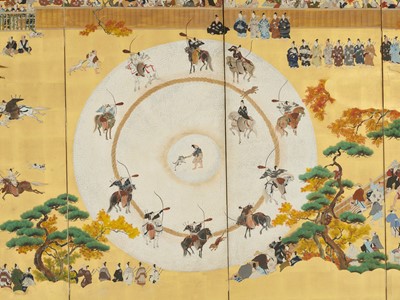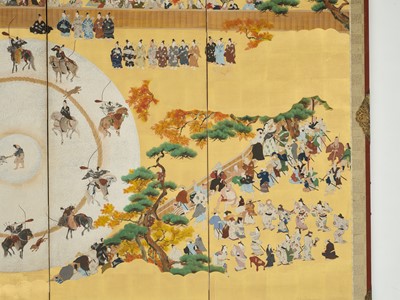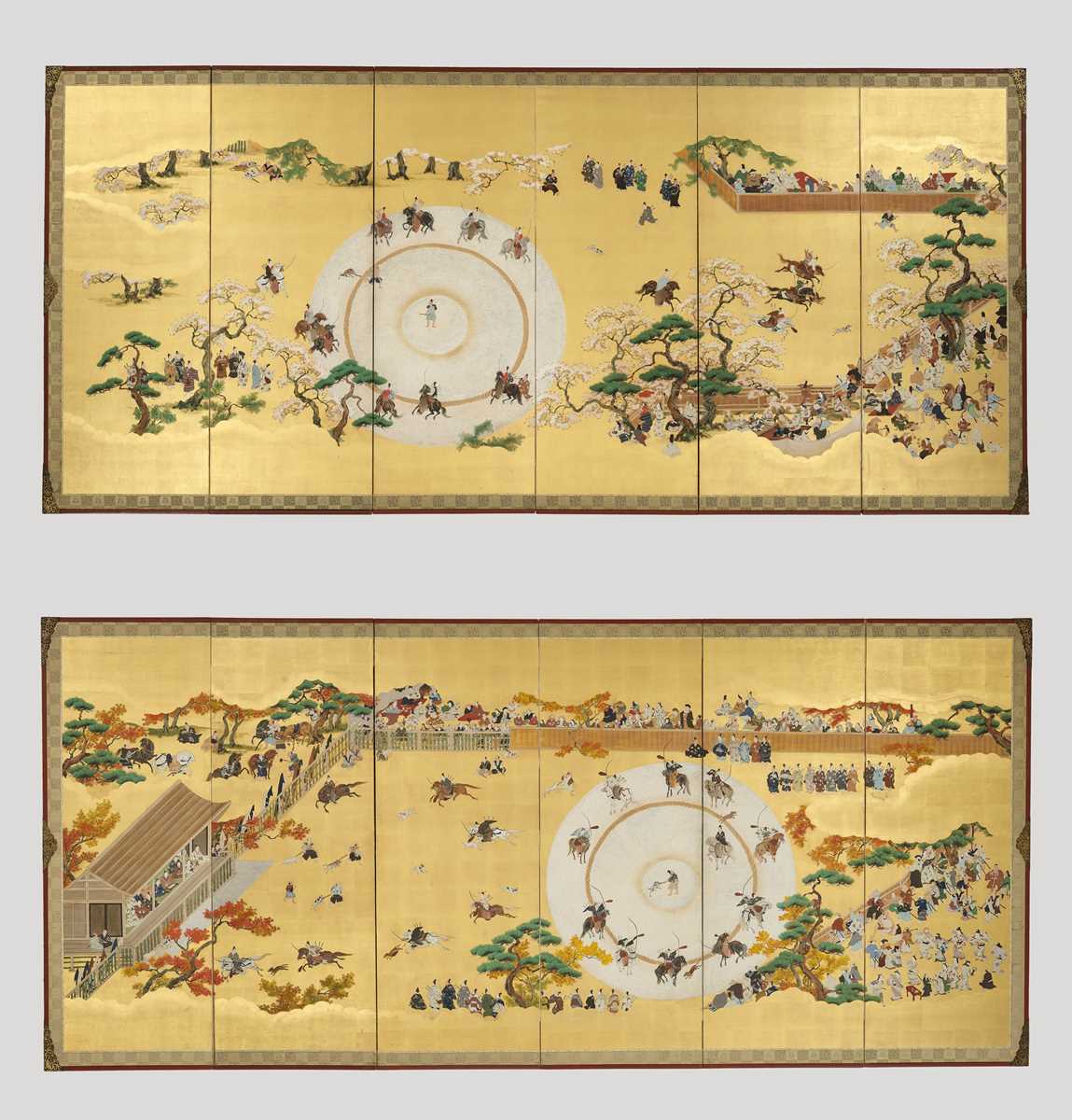16th Jun, 2023 11:00
Fine Japanese Art
70
AN IMPRESSIVE PAIR OF SIX-PANEL BYOBU SCREENS DEPICTING A DOG-CHASING EVENT (INOUMONO)
Sold for €7,150
including Buyer's Premium
Japan, 18th century, Edo period (1615-1868)
Finely decorated with ink, watercolors, and gold foil on paper to depict a large dog-chasing event (inoumono) watched by numerous spectators standing outside the fenced area, along with street vendors and entertainers as well as other contestants, amid gnarled pine and maple trees, as horse-mounted archers chase dogs of all stripes and colors, pointing their large padded arrows at the fleeing canines, with some dogs held by leashes by attendants on foot, including two attendants and three dogs resting under a tree as the chaotic scene unfolds, framed by thick clouds.
SIZE 171.8 x 63.5 cm (each panel) and SIZE (when opened) 171.8 x 367 cm
Condition: Very good condition with minor wear and little soiling, some expected tears and creases, the wood screen with minor nicks and scratches and some old repairs.
Provenance: From the collection of L. Harrison Bernbaum, Chicago, Illinois, USA. L. Harrison Bernbaum is a Chicago businessman who co-founded the outdoor company High Sierra with his father Harry Bernbaum (1917-2015), who had been one of the first American businessmen to travel to Japan in 1956, helping to pioneer manufacturing relationships between America and Japan for the American sporting goods industry.
With a silk brocade frame and mounted to a brown-lacquered screen with parcel-gilt fittings decorated with blossoming flowers and foliate scroll.
Shooting dogs from horseback was a form of samurai training that began in the Muromachi period (1392–1573). During the peaceful 1600s this activity was revived as a samurai sporting event that attracted many spectators. As a sport, dog chasing involved two teams of seventeen participants each. The riders used softly padded arrows in order not to seriously hurt the dog, which was released within a circle of rope to begin the game. A strike on the dog‘s torso scored points; strikes on the head or legs did not count. The winning team usually received prizes of lengths of white silk cloth. The present screen shows the game in progress, with the judges sitting in the building at the left of the field. As many as eighteen pairs of screens on this subject are known in Japan and the West. Later examples, such as this pair, show greater numbers of spectators, probably reflecting the growing popularity of the sport.
Literature comparison:
Compare a closely related six-panel folding screen, also depicting a dog-chasing event, dated approx. 1640, in the collection of the Asian Art Museum of San Francisco, object number B60D1.
Auction comparison:
Compare a closely related single six-panel folding screen, also depicting a dog-chasing event, dated 17th-18th century, 171.5 x 370.8 cm, at Bonhams, Fine Japanese Works of Art, 19 March 2014, New York, lot 3098 (bought-in at an estimate of USD 20,000-30,000).
Japan, 18th century, Edo period (1615-1868)
Finely decorated with ink, watercolors, and gold foil on paper to depict a large dog-chasing event (inoumono) watched by numerous spectators standing outside the fenced area, along with street vendors and entertainers as well as other contestants, amid gnarled pine and maple trees, as horse-mounted archers chase dogs of all stripes and colors, pointing their large padded arrows at the fleeing canines, with some dogs held by leashes by attendants on foot, including two attendants and three dogs resting under a tree as the chaotic scene unfolds, framed by thick clouds.
SIZE 171.8 x 63.5 cm (each panel) and SIZE (when opened) 171.8 x 367 cm
Condition: Very good condition with minor wear and little soiling, some expected tears and creases, the wood screen with minor nicks and scratches and some old repairs.
Provenance: From the collection of L. Harrison Bernbaum, Chicago, Illinois, USA. L. Harrison Bernbaum is a Chicago businessman who co-founded the outdoor company High Sierra with his father Harry Bernbaum (1917-2015), who had been one of the first American businessmen to travel to Japan in 1956, helping to pioneer manufacturing relationships between America and Japan for the American sporting goods industry.
With a silk brocade frame and mounted to a brown-lacquered screen with parcel-gilt fittings decorated with blossoming flowers and foliate scroll.
Shooting dogs from horseback was a form of samurai training that began in the Muromachi period (1392–1573). During the peaceful 1600s this activity was revived as a samurai sporting event that attracted many spectators. As a sport, dog chasing involved two teams of seventeen participants each. The riders used softly padded arrows in order not to seriously hurt the dog, which was released within a circle of rope to begin the game. A strike on the dog‘s torso scored points; strikes on the head or legs did not count. The winning team usually received prizes of lengths of white silk cloth. The present screen shows the game in progress, with the judges sitting in the building at the left of the field. As many as eighteen pairs of screens on this subject are known in Japan and the West. Later examples, such as this pair, show greater numbers of spectators, probably reflecting the growing popularity of the sport.
Literature comparison:
Compare a closely related six-panel folding screen, also depicting a dog-chasing event, dated approx. 1640, in the collection of the Asian Art Museum of San Francisco, object number B60D1.
Auction comparison:
Compare a closely related single six-panel folding screen, also depicting a dog-chasing event, dated 17th-18th century, 171.5 x 370.8 cm, at Bonhams, Fine Japanese Works of Art, 19 March 2014, New York, lot 3098 (bought-in at an estimate of USD 20,000-30,000).
Zacke Live Online Bidding
Our online bidding platform makes it easier than ever to bid in our auctions! When you bid through our website, you can take advantage of our premium buyer's terms without incurring any additional online bidding surcharges.
To bid live online, you'll need to create an online account. Once your account is created and your identity is verified, you can register to bid in an auction up to 12 hours before the auction begins.
Intended Spend and Bid Limits
When you register to bid in an online auction, you will need to share your intended maximum spending budget for the auction. We will then review your intended spend and set a bid limit for you. Once you have pre-registered for a live online auction, you can see your intended spend and bid limit by going to 'Account Settings' and clicking on 'Live Bidding Registrations'.
Your bid limit will be the maximum amount you can bid during the auction. Your bid limit is for the hammer price and is not affected by the buyer’s premium and VAT. For example, if you have a bid limit of €1,000 and place two winning bids for €300 and €200, then you will only be able to bid €500 for the rest of the auction. If you try to place a bid that is higher than €500, you will not be able to do so.
Online Absentee and Telephone Bids
You can now leave absentee and telephone bids on our website!
Absentee Bidding
Once you've created an account and your identity is verified, you can leave your absentee bid directly on the lot page. We will contact you when your bids have been confirmed.
Telephone Bidding
Once you've created an account and your identity is verified, you can leave telephone bids online. We will contact you when your bids have been confirmed.
Classic Absentee and Telephone Bidding Form
You can still submit absentee and telephone bids by email or fax if you prefer. Simply fill out the Absentee Bidding/Telephone bidding form and return it to us by email at office@zacke.at or by fax at +43 (1) 532 04 52 20. You can download the PDF from our Upcoming Auctions page.
How-To Guides
How to Create Your Personal Zacke Account
How to Register to Bid on Zacke Live
How to Leave Absentee Bids Online
How to Leave Telephone Bids Online
中文版本的操作指南
创建新账号
注册Zacke Live在线直播竞拍(免平台费)
缺席投标和电话投标
Third-Party Bidding
We partner with best-in-class third-party partners to make it easy for you to bid online in the channel of your choice. Please note that if you bid with one of our third-party online partners, then there will be a live bidding surcharge on top of your final purchase price. You can find all of our fees here. Here's a full list of our third-party partners:
- 51 Bid Live
- EpaiLive
- ArtFoxLive
- Invaluable
- LiveAuctioneers
- the-saleroom
- lot-tissimo
- Drouot
Please note that we place different auctions on different platforms. For example, in general, we only place Chinese art auctions on 51 Bid Live.
Bidding in Person
You must register to bid in person and will be assigned a paddle at the auction. Please contact us at office@zacke.at or +43 (1) 532 04 52 for the latest local health and safety guidelines.
